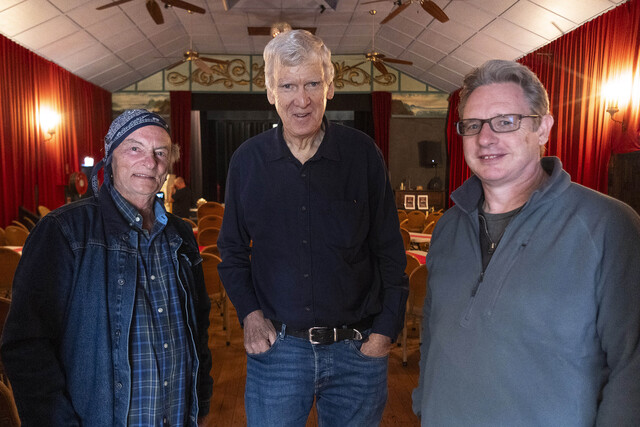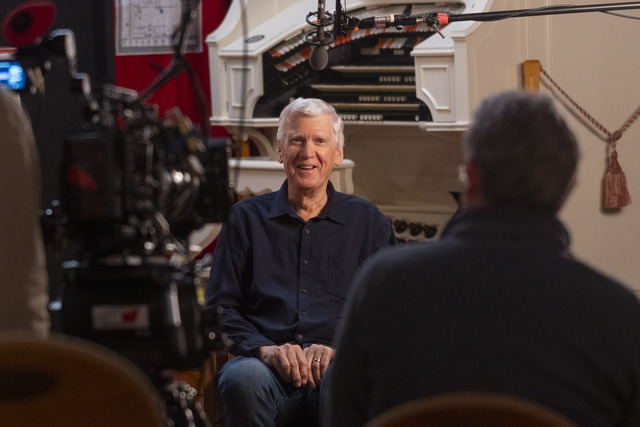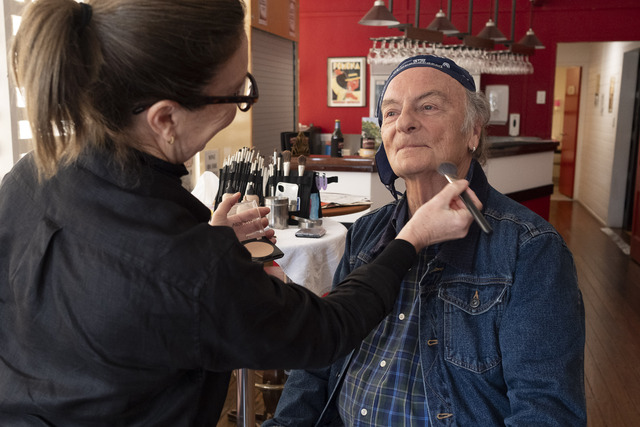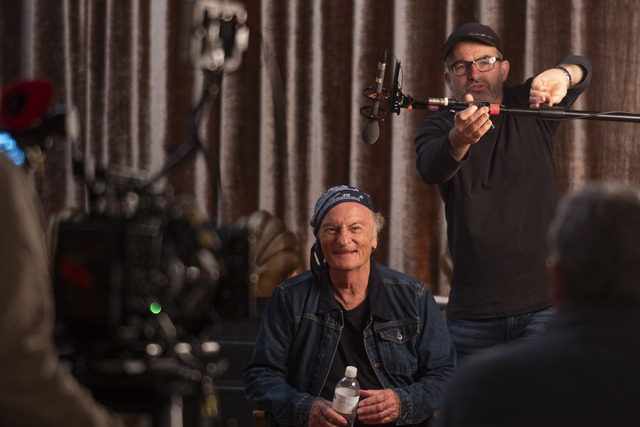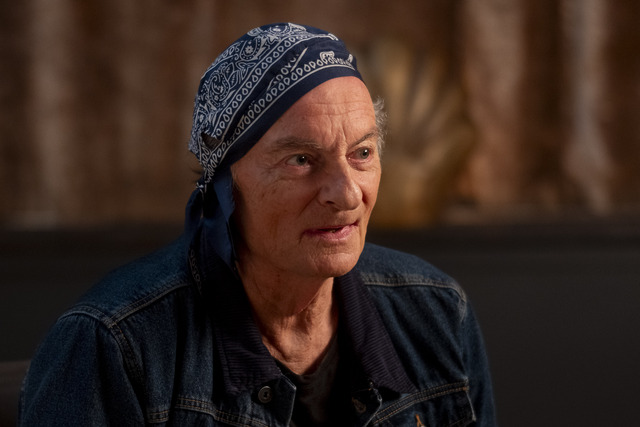A tale of colourful characters and unconventional behaviour forging an Aussi rock identity, fuelled by a killer soundtrack, is to be told by Mark Hartley in his documentary, Sweat It Out!, on the Oz Rock music scene.
Funded by Documentary Australia, directed by Mark Hartley and produced by Cathy Rodda, Sweat It Out! aims to chart the rise and fall of the iconic Australian music scene that began roughly with Johnny O’Keefe, roared through the ’70s, ’80s, and ’90s fading out at the turn of the century with the death of pub rock due to grunge music, iTunes and urban renewal.
As he patches together the documentary, Hartley and his crew have been interviewing 80-100 artists and industry veterans across the country.
Last week they descended on the Majestic Theatre at Pomona to chat with Noosa musician, filmmaker and pioneer of the rock music film clip Chris Lofven and his brother-in-law renowned playwright David Williamson.
“The very first Australian music that struck me in the ’60s was Johnny O’Keefe. It was very loud, very raucous. I didn’t particularly like it very much,“ Williamson told Hartley.
“Then came Billy Thorpe and the Aztecs. It seemed to be a very rocky era in terms of volume, loudness. I wasn’t particularly enthralled. It was part of the soundtrack of your life.“
Williamson remembers the 1960s’ music scene in Australia being dominated by overseas artists then became more Australian in the ’70s with a changing attitude and the help of migrants.
“Without migration Australian music would have been struggling. There was a feeling of a sense of inferiority in Australian artists of all kinds, that they couldn’t possibly compete with the greatness of America and England,“ he said.
“The brashness and confidence of young migrants, they felt they could do it and they did it.
“In the ’70s there was a newfound confidence that Australia could create in the arts, particularly music. There was an explosion of vocal creativity. There was a huge difference in the Whitlam era. He made it very clear Australian arts was a priority. No conservative government had ever had that commitment.
“Whitlam said we have our own voices, our own arts, our own styles, our own themes we should be exploring.“
“The Carlton scene was a hub of energy in ’60s-’70s. It was a place where uni students congregated, the Australian theatre first started, pop music flourished. It was an exciting time.
“My brother-in-law Chris made lots of music clips in the ’60s-’70s. Chris was one of the pioneers of the inventive musical clip and it quickly became apparent that was an essential tool in selling your records. Eagle Rock was the most iconic song in my era in Australian minds and the clip my brother-in-law made had a lot to do with it.“
Chris Lofven told Hartley some of his recollections from that era beginning with the first Australian act to stand out to him – the Easy Beats.
“I thought they were pretty hot. I wanted to play base like the bass player. He inspired me. They had a lot of energy and I think Stevie Wright was just a brilliant front man. They had all original songs, they really rocked.
“Melbourne music scene in the ’60s was pretty lively. There were a lot of clubs, they called them discotheques but they were bars really.
“I joined an established band, we are doing three venues in a night. You’d start off playing a club in town then be off in the suburbs doing a dance, a whole different scene, then go off to another dance. That’s what everyone was doing then.
“We were often doing support for some of big bands. I remember one show, every name band of the day was on the gig.
“We had one single out, getting a bit of air play that’s probably how we got the gig. There was Masters Apprentices, the Twilights. It was out in the middle of footy oval.
“The big bands around all had singles in the charts, that made the difference. If they had a record in the charts they were getting the gigs. They really rocked, that’s who everyone wanted to see. We did a lot of work and made very little money, I could never figure that out.
“It’s hard to imagine how popular bands were with the fans. I think it was governed by radio airplay. That got everyone excited.
“Back in those days everybody had a tranny radio, had the latest hits being played.
“I remember doing beach shows, radio stations would sponsor beach shows, they’d have all types of game activities, guys and girls dancing with Coke cans between them, that was mental.“
Lofven was making short films in his day job and playing in bands so the word spread he could make film clips and requests came for them through his agent.
“We shot them on 16mm film, everything was done economically. I don’t think we charged anything more than a roll of film. I don’t remember taking fees. I had a day job working at film house, doing film clips was a side job. I didn’t expect to get paid.
“I got to do a film clip for Spectrum, made it into a narrative thing.
When Daddy Cool released their first single, Eagle Rock, Pat, the wife of frontman Ross Wilson, saw some live footage of the band that Lofven had shot and thought it’d be great for a film clip.
“It was like Spectrum has one, we’ll have one,“ he said.
“Because they were into the ’50s we thought we’d shoot it in a cafe. We found a cafe in South Melbourne that had a juke box.
“We shot a bit there and a bit at Melbourne zoo, they had Eagles, and a bit on St Kilda esplanade and few live venues as well.
“That film clip became so iconic, the song, of course, it’s still going strong, it’s crazy.“
At the time the film clip wasn’t widely accepted, with few outlets for them but then it changed.
“Countdown was a big plus for the whole music business. It started when colour TV came to Australia in 1975,“ Lofven said.
“If a band wasn’t available to play live it showed the film clip, so sometimes the band didn’t make themselves available.“
Like many artists of the era, Lofven went to the UK after the Eagle Rock clip to gain more experience in the film business, ironically landing his first job on an Aussie film, The Adventures of Barry Mackenzie.
Three years on, the Australian government was making funding available for films so he returned, made a movie, then, at a loss turned to film clips.
“I got in touch with Michael Gudinski, director of Mushroom records, told him I’ve just finished a movie, have you got any bands that need a film clip. Just about every band Michael took on got a film clip. It kept me busy for about 10 years,“ he said.
“Coming up with the ideas was a collaboration with the band, some were pretty crazy, far out ideas. We’d try to do that.
“Kids in the Kitchen was the biggest budget clip for Mushroom records. The band went bananas, came up with crazy ideas that were difficult to achieve.
“We went massively over budget.
“We had troops and police, guns being fired from helicopters.
“It was a big learning curve. I’d never worked with explosives and pyrotechnics. I realised you need experts in the field and we didn’t have that. It’s a wonder no one got killed.
“We had various locations, a deserted monastery, Docklands, a deserted sewerage works, it’d been used for Mad Max.
“It cost as much as mini movie.“
Lofven worked with the biggest bands of the era including ACDC, Little River Band, The Angels, Skyhooks and New Zealand import Split Enz. He had an insiders view of the music scene and a knowledge of the inventiveness required of the day, as well as having a lot of fun along the way.
Filming ACDC performing at the Myer music bowl he said their fans, 12 or 13 year old girls with short hair and black t-shirts were “tough little things“ – “probably tougher than the boys in the band, they were quite nice lads really“.
“We got to work with Split Enz pretty much as soon as they came over from NZ. I had seen clips and knew they were pretty wacky. They arrived looking quite normal, when they came out of the makeup room they looked like nothing else we’d ever seen.
“It got less crazy and more pop when Neil came to forefront, it became quite a different story all together.
“We worked with Skyhooks, Women in Uniform, was a lot of fun. They wanted women in uniform in it. We got permission to go to a police station, they said no we want raunchy stuff. We had to pull in good friends and dress them up.“
Hartley, a multi ARIA and AFI award winning filmmaker who has made more than 150 music videos for Australian and international artists, describes the music business of the Oz Rock-era as a veritable microcosm of Australian society, bubbling with anti-Vietnam sentiments, culture wars, and a taste of liberation with the lifting of censorship. It represented both the best and worst of our country, showcasing a can-do attitude and harnessing a unique, larrikin energy – alongside misogyny and racism, he said.
Sweat It Out is scheduled for release in 2025.

